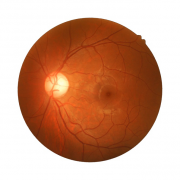Asteroid Hyalosis
This is the only eye condition that can make the inside of your eye look like a star-struck night sky. The only problem is that you can’t see it for yourself, unless your eyecare practitioner takes a photograph of the inside of the eye. Normally, there are no symptoms of asteroid hyalosis at all, and in fact most people who have it don’t know it.
The eyes are filled with a substance called the vitreous humour, or vitreous body, which is a transparent gelatin that takes up the space between the structures in the front of the eye and the retina in the very back.
As we age, the vitreous either thin out and become more liquid, or it becomes thicker, to form clumps or strands we sometimes notice as floaters. Asteroid hyalosis occurs when small calcium and phosphate deposits form and adhere to the vitreous gel, slowly at first, but more deposits appear over time. Eventually, the vitreous becomes filled with multiple yellow or yellow-white particles, suspended on the strands or clumps. As you move your eyes, the deposits also move and sway within the semi-liquid of the vitreous, returning to their original position when the eye stops moving.
The term asteroid hyalosis refers to the reflection of light from the deposits, which make them appear to the viewer as multiple stars in the night sky.
Asteroid hyalosis is relatively common and usually is found in people over 60 years of age; women more often than men have it and it is usually unilateral, effecting only one eye. Typically, people who have this condition have no symptoms at all, although in rare cases it may mildly disturb vision. The biggest problem it usually causes is interference with examination of the structures behind it, the retina, blood vessels and the head of the optic nerve.
The cause of asteroid hyalosis is unknown, but research has shown that it can be associated with diabetes mellitus, hypertension and hypercholesterolemia. Patients who develop the condition should have a physical examination to rule out any of these systemic diseases.
Asteroid hyalosis itself usually doesn’t require treatment, but it is recommended that patients who have it get regular eye exams.






